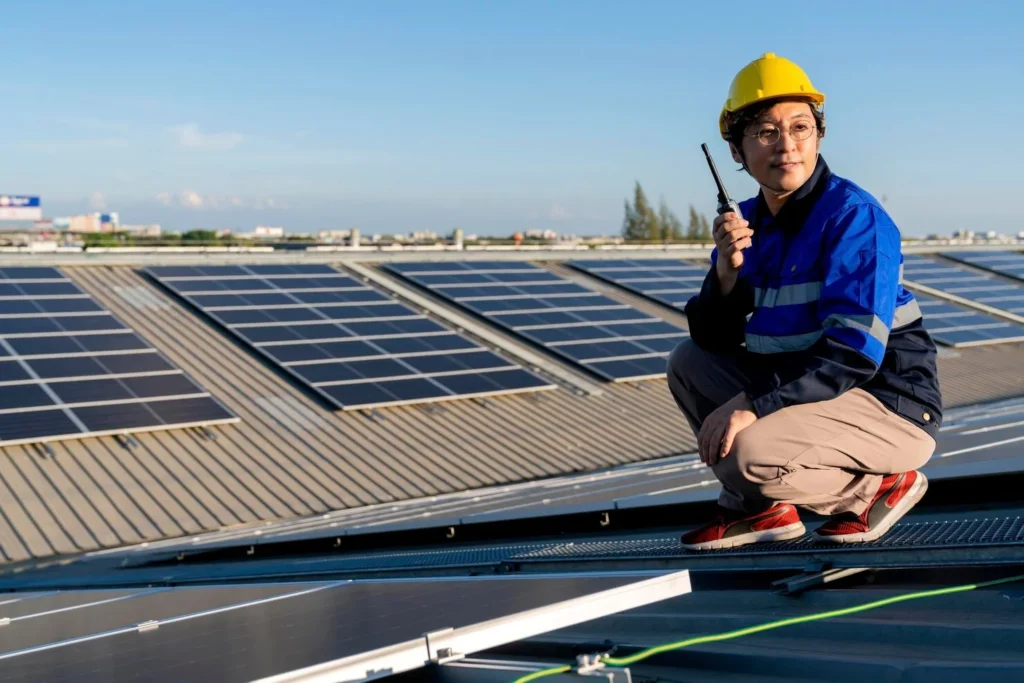Key Takeaways
- Solar-powered roof shingles are an eco-friendly and cost-effective alternative to traditional roofing materials.
- They have the ability to greatly decrease both energy costs and carbon emissions.
- Solar shingles offer aesthetic and functional advantages over conventional solar panels.
- Government incentives and rebates can make the investment more affordable.
Table of Contents
- What Are Solar Shingles?
- How Do Solar Shingles Work?
- Advantages of Solar Shingles Over Traditional Solar Panels
- Costs and Long-Term Savings
- Installation and Maintenance
- Environmental Impact
- Incentives and Rebates
What Are Solar Shingles?
Solar shingles are an innovative roofing material designed to integrate with traditional shingles while seamlessly generating electricity. They transform an entire roof into a solar energy generator, which can be a game-changer for homeowners looking for sustainable energy solutions.
Solar shingles come in various styles, mimicking the look of common roofing materials such as asphalt and slate. This makes them an attractive choice for those who want to maintain their homes’ visual appeal. This dual functionality elevates the home’s aesthetic value and adds a layer of practicality to the traditional roofing concept.
How Do Solar Shingles Work?
Solar shingles are made from photovoltaic (PV) materials that convert sunlight into electricity. Each shingle contains solar cells that capture solar energy. This energy is transformed into usable electrical energy using an inverter system, just like traditional solar panels. The generated power can run household appliances, reducing dependency on external electricity sources. Unlike bulky solar panels, solar shingles offer a sleek and aesthetically pleasing appearance.
The science behind solar shingles involves advanced semiconductor materials. When sunlight hits the PV cells, it knocks electrons loose from their atoms, generating electricity. An inverter converts direct current (DC) electricity into the alternating current (AC) used in households. Moreover, excess energy produced can often be fed back into the power grid, potentially earning homeowners credits or even money through net metering programs.
Advantages of Solar Shingles Over Traditional Solar Panels
Aesthetics
One significant advantage of solar shingles is their aesthetic appeal. Unlike traditional solar panels, which can appear bulky and out of place, solar shingles blend seamlessly with the roof, offering a more visually appealing look. This makes them an excellent choice for homeowners concerned about their property’s appearance. They eliminate the need for mounting racks, giving a uniform and polished look that can enhance curb appeal.
Durability
Solar shingles are created to endure severe weather conditions, making them stronger than traditional solar panels. They are built to last, providing long-term functionality while minimizing maintenance requirements. Most solar shingles are resistant to wind, hail, and extreme temperatures, offering peace of mind to homeowners in areas prone to severe weather.
Efficiency
Progress in solar technology has greatly enhanced the effectiveness of solar shingles. They can now generate as much power as traditional solar panels, making them a practical and efficient alternative. This implies that homeowners can receive all the advantages of solar power without sacrificing performance or appearance.
According to a recent report from CNBC, interest in solar shingles is growing as technology and efficiency improve, making this innovative solution even more attractive to homeowners.
Costs and Long-Term Savings
The initial cost of installing solar shingles may be higher than traditional roofing materials. However, the long-term savings on electricity bills can offset the investment. Over time, homeowners can expect significant reductions in their utility bills, making solar shingles a cost-effective choice in the long run. In addition, solar shingles can increase a property’s market value, offering a financial benefit if the home is sold; the return on investment (ROI) for solar shingles can be substantial. Reducing energy bills typically leads to a payback period during which the initial installation cost is recouped. After this payback period, the energy savings effectively become financial gains. Furthermore, with the continuous increase in electricity costs, the importance of producing one’s power becomes more significant, enhancing the economic advantages.
Installation and Maintenance
Professional installation is required for solar shingles to ensure optimal energy production. While installation can be more complex and time-consuming than traditional roofing installations, the benefits far outweigh the initial setup effort. Skilled installers ensure the shingles are placed in the best possible positions to capture maximum sunlight and generate the most electricity.
Once installed, solar shingles require minimal maintenance. Periodic cleaning and inspections are usually sufficient to keep them functioning efficiently. Any debris or dirt accumulating on the shingles can reduce efficiency, so keeping them clean is essential. Many companies also offer warranties and service plans to address potential issues, ensuring homeowners can maintain their systems with minimal hassle.
Environmental Impact
Solar shingles provide a green energy solution that helps reduce carbon footprints and dependence on fossil fuels. Incorporating solar shingles into homes can significantly reduce greenhouse gas emissions, contributing to environmental conservation. This makes solar shingles not only beneficial for homeowners but also for the planet.
According to Forbes, solar energy is playing a growing role in combating climate change by providing sustainable energy alternatives. Homeowners who opt for solar shingles actively participate in the global effort to reduce carbon emissions and promote renewable energy sources.
Incentives and Rebates
Government incentives and rebate programs are available to make solar technology more affordable for homeowners. These financial incentives can significantly reduce the upfront costs of installing solar shingles, making it easier for more people to benefit from renewable energy. Homeowners should research local and federal programs to maximize their savings when investing in solar shingles.
Incentives can take the form of tax credits, rebates, or grants and vary by location. Some programs may provide direct financial assistance to offset installation costs, while others offer ongoing credits for the energy produced. These incentives reduce the initial financial burden and enhance the long-term savings achieved through reduced energy bills.







